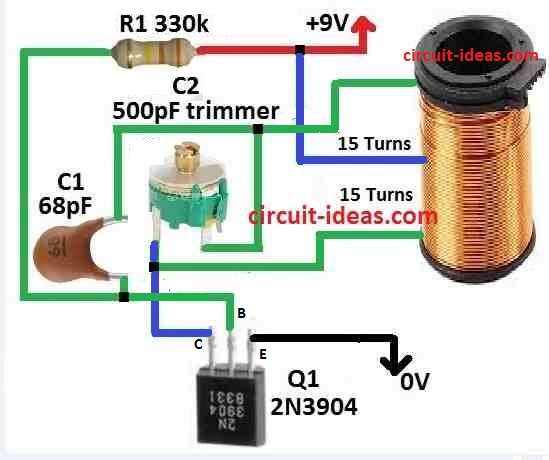This article show a special trick to make a Simple Metal Detector Circuit
It uses simple circuit not like other circuits and needs only one transistor.
The circuit find metal by catching signal from a normal radio.
What is a Metal Detector:
Metal detector is electric circuit made to check if metal is close or not.
It works using electromagnetic induction when metal comes near and it changes the frequency of special circuit.
Metal detector are used in many place like factory, treasure hunting, airport security and old history digging.
Circuit Working:

Parts List:
| Category | Description | Quantity |
|---|---|---|
| Resistor | 1/4 W CFR | |
| 330k | 1 | |
| Capacitors | ||
| Ceramic 68pF | 1 | |
| Trimmer 500pF | 1 | |
| Semiconductor | ||
| Transistor 2N3904 | 1 | |
| Search Coil as given in the text | 1 |
Below we can explain how metal detector circuit work:
First take plastic round base 3 to 4 inch wide and wind wire on it 30 times and this will make coil called L1.
Connect L1 to circuit using three wires which will become search coil or sensor.
To is used for ground metal finding and fixes coil at end of long wood or plastic stick.
To find metal at inside walls keep whole circuit inside small box so we can carry easily.
The circuit work when metal come close and disturb the electromagnetic field made by coil L1.
When metal come L1s value and frequency both changes.
Use small battery radio near circuit.
The radio catches this change and make loud sound.
First tune radio to local station an we will hear beat or small flutter sound.
Now turn capacitor C1 slowly until we hear low beat or chirp which mean it is set right.
When metal is near the sound changes more and this will help find hidden metal.
Circuit find changes in field made by L1 when metal is there.
Radio make these changes louder so its easy to know metal is there.
Capacitor C1 need to adjust correct to get strong signal.
Formula:
Below formula helps to find starting frequency of metal detector circuit:
f = 1 / 2π√(L * C)
where:
- f is how fast circuit vibrate in Hertz Hz and this is called resonant frequency which is the natural speed where circuit work best.
- 2π is two times pi to about 3.14159 which comes often in wave and vibration math.
- L is coils inductance in henries H where coil stops quick change in current.
- C is capacitors value in farads F where capacitor keep electric charge for short time.
- √ mean square root.
How formula work:
Multiply L and C which then take square root and then multiply by 2π and do 1 divided by that number which then gives f.
If we make C or L bigger frequency f go down.
If C or L is smaller then f goes up.
This help set circuit to correct working speed. lower capacitance or inductance.
How to Build:
The following are the connections steps for building a Simple Metal Detector Circuit.
Make Oscillator Coil L1:
- Take plastic round bobbin 3 to 4 inch wide.
- Wrap 30 turns of insulated wire on it.
- Be sure wire is tight and neat.
Connect Coil to Circuit:
- Use three wire cable to join coil L1 to circuit.
- Now L1 starts sensing coil
Build Circuit on Breadboard:
- Put transistor on breadboard.
- Find out which pin is emitter, base and collector.
- Connect coil L1 to emitter and collector sides.
- Add resistors if needed to set transistor properly.
- Also put variable capacitor C1 into the circuit.
- Change value of C1 to adjust circuit tuning.
Set Up Radio Receiver:
- Keep radio near the circuit.
- Connect it with proper wire.
- Check radio antenna is placed good for strong signal.
Power the Circuit:
- Connect battery to give power.
- Check that transistor can handle battery voltage.
Test the Circuit:
- Turn the circuit ON.
- Set radio to local FM/AM station.
- Listen to speaker we may hear soft beat or flutter sound.
- Turn C1 slowly until low beat or chirp sound come, this means tuning is working.
Try Metal Detecting:
- Bring circuit close to metal.
- If metal is near radio sound will change and the beat will go faster or louder.
- This mean metal is detected.
Improve the Circuit:
- To make circuit better try different values for capacitor or make small changes in design.
- Keep testing to find what gives best result for metal finding.
Conclusion:
Anyone can make working Simple Metal Detector Circuit by following these above steps.
If we need for different metal finding job we can change circuit like use different capacitor values or change coil design.
Leave a Reply